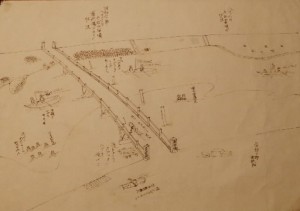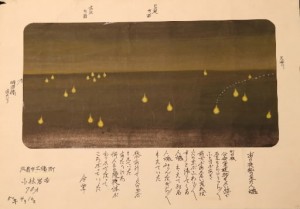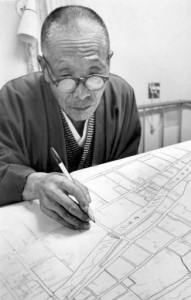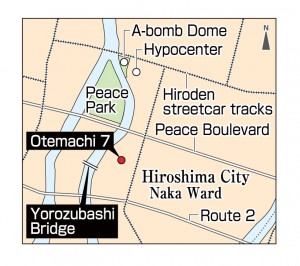Hiroshima: 70 Years After the A-bombing: Depicting the A-bombing 2
Sep. 25, 2014
Single drawing honoring the dead: Resonated with public
Twenty-five years after the atomic bombing, an elderly man took an A-bomb drawing he had done to the regional offices of NHK (now its Hiroshima studios). The work of Iwakichi Kobayashi, who lost his wife and son in the atomic bombing, became known throughout the nation thereafter. At the time, Hiroshima was experiencing rapid growth, and there was concern that memories of the atomic bombing experience were fading and would not be passed on.
Desire to depict scene before dying
On May 15, 1974, Mr. Kobayashi, then 76, visited NHK’s local offices and showed his picture to a receptionist. On the picture he had written: “Conditions in the vicinity of the Yorozuyo Bridge around 4 p.m. on August 6, 1945.” When the receptionist offered to take the drawing from him, Mr. Kobayashi, who was rather old-fashioned, was reluctant to turn it over to her, so a young director came out to speak with him.
Toyohiko Harada, 67, who later became general manager of NHK’s Hiroshima studios, recalled that first encounter with Mr. Kobayashi. “I was shocked by the vivid memories he talked about with such emotion and the feelings those memories held for him.” Mr. Harada had been working for NHK for only four years, and Hiroshima was his first post.
Mr. Kobayashi’s picture was done on drawing paper using a felt-tip pen. It depicts what he saw in the Yorozuyo Bridge area, about 880 meters from the hypocenter, where he had come in search of his wife and son. According to Mr. Harada, Mr. Kobayashi said the image was indelibly engraved in his mind and he was determined to put it on paper before he died.
Mr. Harada went to work on a program about Mr. Kobayashi’s picture. A colleague proposed a campaign to solicit art related to the A-bombing from viewers. On the morning of June 8, a 15-minute program about Mr. Kobayashi’s picture was aired locally.
On his picture Mr. Kobayashi had written: “A naked young girl covered herself with a scorched piece of corrugated metal.” In the program he talked about this and other memories of the day of the atomic bombing. Artist Goro Shikoku, who drew the cover illustration for Sankichi Toge’s “Poems of the Atomic Bomb,” also appeared on the program. He called on people to submit their artwork and suggested that they add written descriptions if they could not accurately depict what they had seen. (Mr. Shikoku died in March of this year at the age of 89.)
The call for artwork drew an enthusiastic response from the public, and many people submitted pictures to NHK in person and by mail. The following year, on August 6, 1975, a 45-minute program on the public’s A-bombing art was broadcast nationwide, and over the course of two years NHK received 2,225 works of art from 758 people.
“Mr. Kobayashi depicted his experiences in a simple way with a desire to honor the memory of those who had died,” Mr. Harada recalled. “Because his picture was the first, more and more people thought to themselves: ‘I’ll draw a picture too.’” He added, “There is a limited amount of footage of the atomic bombing. The A-bombing art was an attempt to have the gaps filled in by citizens.”
Recounting experiences into later years
Mr. Kobayashi, whose drawing inspired the A-bombing art effort, also participated in the campaign by high school students and others to collect roof tiles that had survived the A-bombing. Some of the tiles were used on the Hiroshima Monument for the A-bomb Victims, which was erected on the east bank of the Motoyasu River in 1982. At its unveiling Mr. Kobayashi related his A-bombing experiences as a representative of victims’ families.
Hiroshima resident Mareaki Yamashita, 81, served as director of the effort to erect the monument. He became acquainted with Mr. Kobayashi after he sent a letter of support for the project. In his letter, Mr. Kobayashi said that with the rebuilding of the city all traces of the atomic bombing were completely disappearing.
According to city records and Mr. Kobayashi’s memoirs, which were published in 1971, before the war Mr. Kobayashi ran a furniture manufacturing business and was a member of the municipal fire brigade.
When the atomic bomb was dropped on August 6, 1945, he was employed as a temporary laborer in the inspection section of the Hiroshima Division of the National Railways and was working near Hiroshima Station. Five days later he found the bodies of his wife Kishino, 38, and son Yukio, 12, a third-year student at Otemachi National School, near their home in Otemachi.
In 1968 Mr. Kobayashi underwent surgery for cancer of the rectum at the Hiroshima Atomic Bomb Hospital. Inspired by a campaign led by Hiroshima University’s Research Institute for Nuclear Medicine and Biology to recreate the hypocenter area, Mr. Kobayashi drew a map of the streets and main shops of the Hiroshima delta before the A-bombing.
After the war he made his living as a joiner, and into his later years he recounted his A-bombing experiences to students who came to Hiroshima on school trips. In 1991 he entered Kandayama Yasuragi-en, a nursing home for atomic bomb survivors in Higashi Ward, and died there six months later in November at the age of 93. Seven of Mr. Kobayashi’s A-bomb pictures are in the collection of the Peace Memorial Museum.
(Originally published on September 15, 2014)











